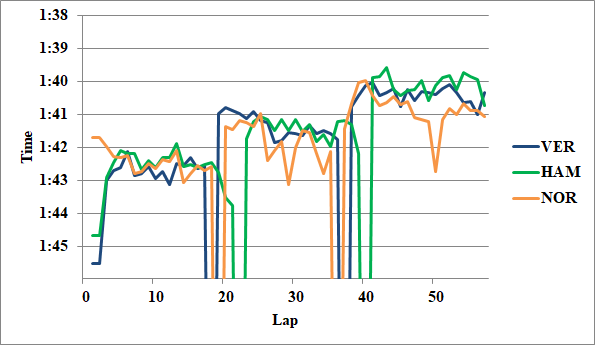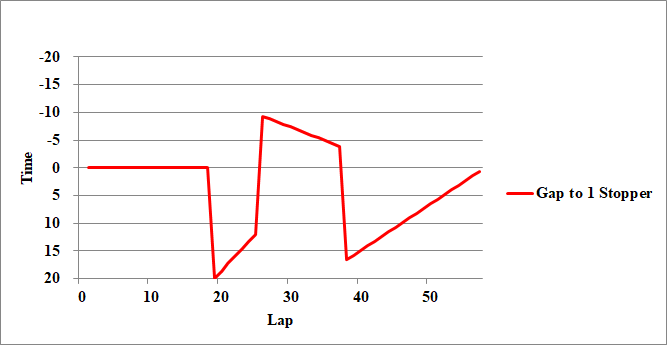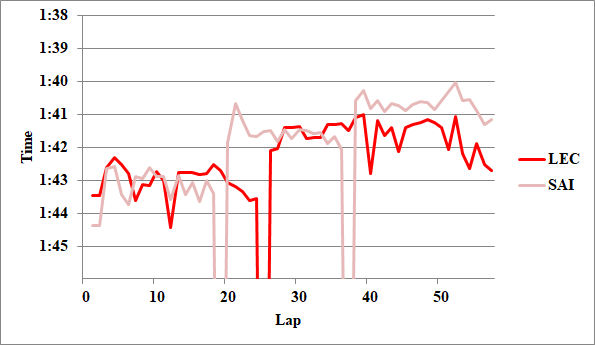
F1 has arrived in America, where its popularity is surging. Although Verstappen clinched the championship title in Qatar GP a week ago, there’s no such thing as a dead rubber in F1. In this article, we’ll delve into the numerous on-track battles at COTA, a circuit featuring high-speed S curves, combined corners, and lengthy straights, from an analytical perspective.
Pirelli Official Tyre Strategies for Each Driver
1. Verstappen’s Strategy
In qualifying, Verstappen’s time was deleted due to exceeding track limits. Consequently, he started the race from P6. However, in the first stint, he overtook Sainz on lap 5 and Leclerc on lap 11, moving up to third position. For a deeper understanding of the events that followed, let’s analyze the race pace of Verstappen, Hamilton, and Norris, as shown in Fig.1.

What surprised me the most was Red Bull and Verstappen’s decision to pit on lap 16. I had anticipated Verstappen extending his first stint, which produces the tyre offset, and then overtaking Norris and Hamilton in the subsequent stints. Surely, many viewers had similar expectations.
Let’s break down this strategy.
1.1. Downsides of Pitting Early
The disadvantages of pitting early include:
- The 4.3-second gap to Hamilton would be too small to achieve a successful undercut if Hamilton reacted the following lap.
- Verstappen would need to compete in the second stint with older tyres than his rivals.
While actually Mercedes and Hamilton chose to stretch out the first stint, had he pitted on lap 17, Verstappen would have faced two rivals with tyres one lap fresher (equivalent to 0.07[s/lap]). Hamilton’s on-track pace was better than Norris’s, making an overtake a significant challenge. Moreover, if Hamilton caught up to Norris and formed a DRS train, it would have further complicated things for Verstappen.
Hamilton’s choice to extend the first stint might be attributed to believing he had no chance of beating Norris if he pitted on the same lap as Norris. Hence, even if it meant giving up positions to Verstappen, prioritizing building an offset to Norris makes sense. In reality, Hamilton pitted three laps after Norris, and managed to pull one more lap in the second stint, and successfully overtook Norris in the third stint with four laps fresher tyres.
1.2. Upsides of Pitting Early
On the flip side, following is the merits.
- Forcing Norris to run more laps on the hard tyres.
- Ending a disadvantageous first stint sooner.
- Achieving a successful undercut if Hamilton decided to stay out.
In a post-race comment, Horner mentioned that the choice to run mediums in the second stint was based on Norris having to run the latter half of the race on hards. This suggests that Red Bull viewed the medium tyre as superior. Hence, making Norris run longer stints on the hard tyres was ideal. By undercutting early and inducing a reaction the next lap, which was achieved.
Furthermore, Verstappen’s pace at the end of his first stint wasn’t particularly strong. As seen in Fig.1, after getting clear air on lap 12, his pace was on par with Hamilton’s. Taking tyre degradation and fuel effect into account, Verstappen was about 0.2 seconds faster than Hamilton in the subsequent stints. This suggests Verstappen couldn’t fully capitalize on his car’s potential in the first stint, possibly due to the earlier battles with the Ferraris in dirty air which increased tyre degradation.
Thus, persisting with the worn tyres wouldn’t have closed the gap to the front two, probably placing him at a significant disadvantage starting the second stint. An early pit stop was likely the right move.
Lastly, as it turned out, Mercedes and Hamilton prioritized overtaking Norris over retaining position against Verstappen. Red Bull could have anticipated this from Mercedes, and if they did so, what a amazing chess game they played…
In summary, while the lap 16 pitstop had its both positive and negative sides, given the circumstances, it was probably the best possible decision for Red Bull.
1.3. A World of What-Ifs
However, What made Verstappen be able to overtake Norris in the critical second stint might partially be attributed to a minor mistake by Norris. As shown in Fig.1, Norris locked up at Turn 11 on lap 25 and put 2 slow laps and couldn’t fully recover his pace until he was overtaken. Possibly it was due to overheating from the lock-up. This amplified the pace difference between the two from the 0.2-0.3 seconds to a massive 0.7 seconds, allowing Verstappen to execute an overtake on lap 28.
Had Norris not made this error, Verstappen’s early pit strategy could have been severely compromised by the older tyres, making it difficult to overtake Norris.
The race had various factors interplaying, with the outcome remaining unpredictable. While the best strategy always comes with potential downsides, decisions from Mercedes and Hamilton, a slight mistake from Norris, and a flawless drive from Verstappen all contributed to the positive final outcome.
2. Ferrari’s Strategy Dilemma
The spotlight in this race, unfortunately, shone on Leclerc’s strategic setback. While leading Sainz during the first stint, he committed to a one-stop strategy, and be overtaken by Sainz on the Lap 50.
Fig.2 presents the gap simulation between a one-stop and a two-stop strategy, both factoring in a fuel effect and tyre degradation rate of 0.07[s/lap], and Fig.3 depicts the actual race pace of Leclerc and Sainz.


From Fig.2, assuming both drivers run a clean race, the one-stop and two-stop strategies appear nearly identical in potential outcomes.
However, real races are never that straightforward. Two significant variables come into play: dealing with traffic and tyre drop-off.
Traffic usually make it challenging for the two-stoppers, but COTA, with its overtaking-friendly layout, minimises the time lost when there’s a noticeable tyre advantage. This made the two-stop strategy more favourable this time around.
Yet, referring to Fig.3, there’s a distinct drop-off in Leclerc’s tyre performance towards the end of his first stint, costing him about two seconds.
However, this alone doesn’t explain why he eventually finished a substantial eight seconds behind Sainz. Delving into the race pace data, once on the hard tyres, Leclerc’s pace was roughly 0.1 seconds slower per lap than Sainz’s. This relatively slow pace contributed to his struggles later in the race.
Whether this 0.1-second difference arose from Leclerc’s performance or from managing the tyres for 33 laps remains unclear. But considering Red Bull’s staunch commitment to a two-stop strategy from the start, it’s possible Ferrari might have underestimated the latter aspect.
Regardless, it would be unfair to outright condemn Ferrari’s one-stop choice. The team splited strategies between Sainz and Leclerc: positioning Leclerc to capitalise if traffic became an issue, and Sainz if tyre management took precedence, suggesting a well-thought-out team operation.
The drivers duo of Ferrari could rank among the top across all teams. If Ferrari can couple this driver talent with competitive machinery and team strategy next season, they could very well emerge as formidable contenders against Red Bull.
Writer: Takumi